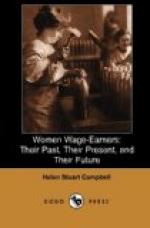Silk growing and weaving had been the result of the silkworm cocoons sent over by James the First, who offered bounties of money and tobacco for spun and woven silk according to weight. Three women were famous before the Revolution as silk growers and weavers,—Mrs. Pinckney, Grace Fisher, and Susanna Wright; and at all points where the mulberry-tree was indigenous or could be made to grow, fortune was regarded as assured. The project failed; but the efforts then made paved the way for present experiment, and even better success than that already attained.
The manufacture of straw goods, amounting now to many million dollars yearly, owes its origin to a woman,—Miss Betsey Metcalf, who in 1789, when hardly more than a child, discovered the secret of bleaching and braiding the meadow grass of Dedham, her native town. Others were taught, and a regular business of supplying the want for summer hats and bonnets was organized, and has grown to its present large proportions.
At this period women widowed by the fortune of war or forced by the absence of all the male members of the family on the field, were often found in business. The mother of Thomas Perkins of Salem, one of the great American merchants, left widowed in 1778, took her husband’s place in the counting-house, managed business, despatched ships, sold merchandise, wrote letters, all with such commanding energy that the solid Hollanders wrote to her as to a man.[12] The record of one day’s work of Mary Moody Emerson, born in 1777, reads:—
“Rose before light every morn; read Butler’s Analogy; commented on the Scriptures; read in a little book Cicero’s Letters—a few touches of Shakespeare—washed, carded, cleaned house and baked."[13]
There is another woman no less busy, a member of the distinguished Nott family, who did work in her house and helped her boys in the fields. In midwinter, with neither money nor wool in the house, one of the boys required a new suit. The mother sheared the half-grown fleece from a sheep, and in a week had spun, wove, and made it into clothing, the sheep being protected from cold by a wrappage made of braided straw.
Details like this would be out of place here did they not serve to accent the fact of the concentration of industries under the home roof, and the necessity that existed for this. But a change was near at hand, and it dates from the first bale of cotton grown in the country.
In the early years of the eighteenth century not a manufacturing town existed in New England, and for the whole country it was much the same. A few paper-mills turned out paper hardly better in quality than that which comes to us to-day about our grocery packages. In a foundry or two iron was melted into pigs or beaten into bars and nails. Cocked hats and felts were made in one factory. Cotton was hardly known.[14] De Bow, in his “Industrial Resources of the United States,” tells us that a little had been sent to Liverpool just before the battle of Lexington; but linen took the place of all cotton fabrics, and was spun at every hearth in New England.




